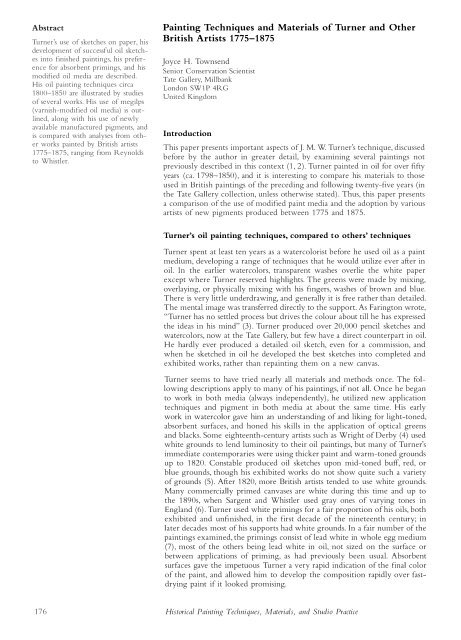Historical Painting Techniques, Materials, and Studio Practice
You also want an ePaper? Increase the reach of your titles
YUMPU automatically turns print PDFs into web optimized ePapers that Google loves.
Abstract<br />
Turner's use of sketches on paper, his<br />
development of successful oil sketches<br />
into finished paintings, his preference<br />
for absorbent primings, <strong>and</strong> his<br />
modified oil media are described.<br />
His oil painting techniques circa<br />
1800-1850 are illustrated by studies<br />
of several works. His use of megilps<br />
(varnish-modified oil media) is outlined,<br />
along with his use of newly<br />
available manufactured pigments, <strong>and</strong><br />
is compared with analyses from other<br />
works painted by British artists<br />
1775-1875, ranging from Reynolds<br />
to Whistler.<br />
<strong>Painting</strong> <strong>Techniques</strong> <strong>and</strong> <strong>Materials</strong> of Turner <strong>and</strong> Other<br />
British Artists 1775-1875<br />
Joyce H. Townsend<br />
Senior Conservation Scientist<br />
Tate Gallery, Millbank<br />
London SW 1P 4RG<br />
United Kingdom<br />
Introduction<br />
This paper presents important aspects of J. M. W Turner's technique, discussed<br />
before by the author in greater detail, by examining several paintings not<br />
previously described in this context (1, 2). Turner painted in oil fo r over fifty<br />
years (ca. 1798-1850), <strong>and</strong> it is interesting to compare his materials to those<br />
used in British paintings of the preceding <strong>and</strong> fo llowing twenty-five years (in<br />
the Tate Gallery collection, unless otherwise stated). Thus, this paper presents<br />
a comparison of the use of modified paint media <strong>and</strong> the adoption by various<br />
artists of new pigments produced between 1775 <strong>and</strong> 1875.<br />
Turner's oil painting techniques, compared to others' techniques<br />
Turner spent at least ten years as a watercolorist before he used oil as a paint<br />
medium, developing a range of techniques that he would utilize ever after in<br />
oil. In the earlier watercolors, transparent washes overlie the white paper<br />
except where Turner reserved highlights. The greens were made by mixing,<br />
overlaying, or physically mixing with his fingers, washes of brown <strong>and</strong> blue.<br />
There is very little underdrawing, <strong>and</strong> generally it is free rather than detailed.<br />
The lTlental image was transferred directly to the support. As Farington wrote,<br />
"Turner has no settled process but drives the colour about till he has expressed<br />
the ideas in his mind" (3). Turner produced over 20,000 pencil sketches <strong>and</strong><br />
watercolors, now at the Tate Gallery, but few have a direct counterpart in oil.<br />
He hardly ever produced a detailed oil sketch, even for a commission, <strong>and</strong><br />
when he sketched in oil he developed the best sketches into completed <strong>and</strong><br />
exhibited works, rather than repainting them on a new canvas.<br />
Turner seems to have tried nearly all materials <strong>and</strong> methods once. The following<br />
descriptions apply to many of his paintings, if not all. Once he began<br />
to work in both media (always independently) , he utilized new application<br />
techniques <strong>and</strong> pigment in both media at about the same time. His early<br />
work in watercolor gave him an underst<strong>and</strong>ing of <strong>and</strong> liking fo r light-toned,<br />
absorbent surfaces, <strong>and</strong> honed his skills in the application of optical greens<br />
<strong>and</strong> blacks. Some eighteenth-century artists such as Wright of Derby (4) used<br />
white grounds to lend luminosity to their oil paintings, but many of Turner's<br />
immediate contemporaries were using thicker paint <strong>and</strong> warm-toned grounds<br />
up to 1820. Constable produced oil sketches upon mid-toned buff, red, or<br />
blue grounds, though his exhibited works do not show quite such a variety<br />
of grounds (5). After 1820, more British artists tended to use white grounds.<br />
Many commercially primed canvases are white during this time <strong>and</strong> up to<br />
the 1890s, when Sargent <strong>and</strong> Whistler used gray ones of varying tones in<br />
Engl<strong>and</strong> (6) . Turner used white primings for a fair proportion of his oils, both<br />
exhibited <strong>and</strong> unfinished, in the first decade of the nineteenth century; in<br />
later decades most of his supports had white grounds. In a fair num.ber of the<br />
paintings examined, the primings consist of lead white in whole egg medium<br />
(7), most of the others being lead white in oil, not sized on the surface or<br />
between applications of priming, as had previously been usual. Absorbent<br />
surfaces gave the impetuous Turner a very rapid indication of the final color<br />
of the paint, <strong>and</strong> allowed him to develop the composition rapidly over fastdrying<br />
paint if it looked promising.<br />
176<br />
<strong>Historical</strong> <strong>Painting</strong> <strong>Techniques</strong>, <strong>Materials</strong>, <strong>and</strong> <strong>Studio</strong> <strong>Practice</strong>


